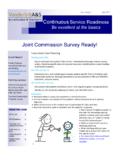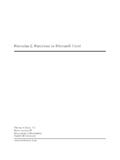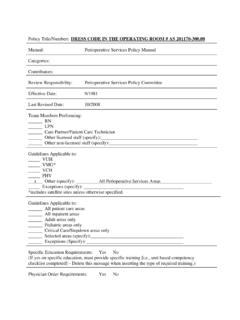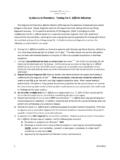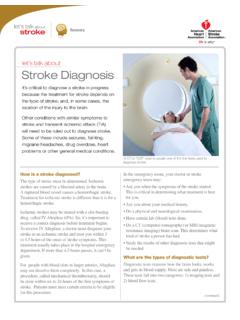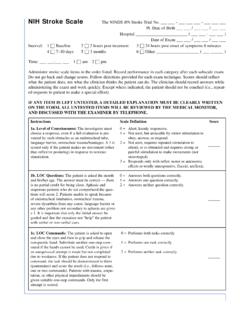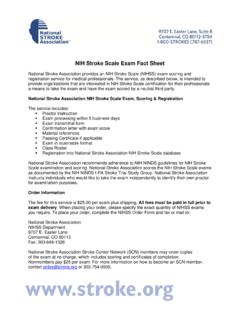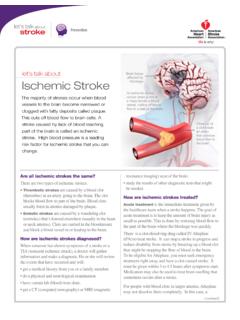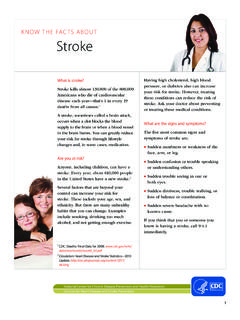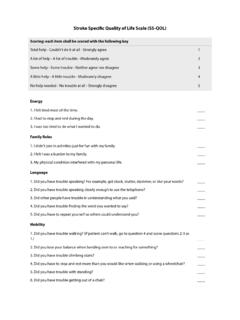Transcription of Assessing the Stroke Patient - mc.vanderbilt.edu
1 Assessing the Stroke Patient Arlene Boudreaux, MSN, RN, CCRN, CNRN Cincinnati Pre-Hospital Stroke Scale May be done by EMS oOne of many oF facial droop on one side oA arm drift (hold a pizza box, close your eyes) oS - speech have Patient say the sky is blue in Cincinnati or you can t teach an old dog new tricks oT time of onset MEND Miami Emergency Neurological Deficit No number score Report will include each response Standard Presentation Left sided Stroke (MCA or parts) Aphasia inability to speak or understand spoken word oMay produce word salad oMay affect swallow on either side Left lateral gaze Right visual field deficit Right hemiparesis Right hemisensory loss Right sided Stroke (MCA or parts) Flat affect Right lateral gaze Left visual field deficit Left hemiparesis/hemisensory Unaware of deficits!
2 Nonverbal memory impaired oFood smell on NPO patients What if it isn t FAST? Other arteries Ruptured aneurysms Intracerebral bleeds oArterial oLacunar oVenous sinus Central retinal artery occlusion Sudden is Key Sudden numbness or weakness of an extremity Sudden confusion, trouble speaking or understanding Sudden trouble seeing in one or both eyes Sudden trouble walking, dizziness, or loss of balance Sudden severe headache with no known cause Vertebro-Basilar Stroke Diplopia double vision Dysphagia difficulty swallowing Dysarthria speech difficulty R/T coordination of larynx, tongue, etc Dizziness Deafness, tinnitus Double hemisensory or hemiparesis (both sides) Drop attacks Acute vestibular syndrome Incomplete basilar Stroke may result in only intractable vomiting May have an NIHSS of 0 Cerebellar Fine Movement Coordination Balance Not strength Use of feedback loops Assess finger-nose, PICA Posteroinferior Cerebellar artery SCA Superior Cerebellar artery Occipital Lobe Typically vision changes oBlindness oDenial of deficit oVisual field cuts oHomonymous hemianopia oIllusion/hallucination oAgnosias Amnesia PCA Posterior Cerebral Artery Parietal Lobe Sensation!
3 OIdeomotor praxis on dominant side (do what I do/say) oSpatial orientation on nondominant oTouch, pressure, position for each side Temporal Lobe Seizures Receptive aphasia may appear to be confusion Interpretive area memories Assessment involves stories, Involve family Dominant lobe verbal memory Nondominant lobe nonverbal Frontal Strokes Right frontal strokes may present as oMania oDelirium oDelusions Left frontal strokes may present as oDepression oDiminished affect oAlien hand syndrome oMonotonous speech The Stuff on the Inside Basal Ganglia Includes Putamen, Globus Pallidus, Caudate Nucleus, Amygdaloid Body, and Claustrum Thalamic Strokes Mania All senses except smell Pain awareness Attention RAS Limbic system Midbrain (green)
4 Visual field deficit Hearing impairment Uncoordinated body movement Involuntary eye movement Assess EOMs Coordination Midbrain Posterior Cerebral Artery Top of the Basilar syndrome oUnconscious oQuadriplegic oPupil abnormalities oEOM deficits oMay be incontinent Pontine Alteration of smell, taste, hearing, or vision (total or partial) Urinary incontinence Drooping of eyelid (ptosis) and weakness of ocular muscles Decreased reflexes: swallow, gag and pupil reactivity to light Decreased sensation and muscle weakness of the face Weakness in tongue Nystagmus (involuntary eye movement) Alteration of breathing pattern Penetrating arteries branching off the Basilar feed the Pons Origins of CNs V - VIII Larger Pontine Bleeds Coma Quadriplegia Ophthalmoparesis (weak occulomotor muscles) Pinpoint pupils Poor prognosis Medulla Stimulates the intercostal muscles and diaphragm Regulates heartbeat Regulates the diameter of arterioles thus adjusting blood flow Autonomic functions such as vomiting and digestion.
5 Cranial Nerves IX XII origins Fed by Vertebral arteries Medulla Assess chest wall expansion, deep breathing Telemetry Blood pressure GI function Cough and gag Swallow Shrug Step by Step Presenting symptoms Location of the Stroke oBleed or occlusion Expand your assessment to include possible S/S for that area Then expand to include possible S/S for adjacent areas Questions?

